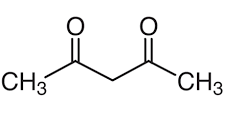HI! I’M ELEMENT AI.
Acetyl Acetone

Product Description
Acetyl acetone is a chemical compound with various industrial and commercial applications.
Product:
Acetyl Acetone
CAS:
123-54-6
Synonym:
2,4-Pentanedione; Acetoacetone; Pentane-2,4-dione; Acetylacetone
Structure:

Typical Characteristics
Appearance
Colorless or slightly yellowish liquid
Boiling point
140.5 °C
Density
0.9721 g/cm3
Flash Point
34°C
Melting point
-23.5 °C
Molecular Weight
100.12
Odor
Pleasant, ester-like odor
Purity
≥99%
Refractive index
1.452
Uses, Applications & Markets
Key applications
get a quote
We Offer Acetyl Acetone
in various grades
A few of the grades available are listed below:



Acetyl Acetone used in many
industry applications
Acetyl acetone, also known as pentane-2,4-dione, is a chemical compound with various industrial and commercial applications. Here's a list of some of its uses:
- Chemical Synthesis: Acetyl acetone is widely used as a chemical intermediate in organic synthesis reactions. It serves as a precursor for the synthesis of various compounds, including pharmaceuticals, agrochemicals, and specialty chemicals.
- Chelating Agent: Acetyl acetone is a bidentate ligand and forms stable complexes with metal ions such as copper, iron, and aluminum. It is used as a chelating agent in analytical chemistry, metal extraction, and metal surface treatment processes.
- Coating and Adhesives: Acetyl acetone is used in coatings and adhesives formulations as a crosslinking agent, curing agent, or surface modifier. It helps improve adhesion, hardness, and chemical resistance of coatings and adhesives.
- Chemical Analysis: Acetyl acetone is utilized in analytical chemistry techniques such as spectrophotometry and chromatography for the determination of metal ions in samples. It forms colored complexes with metal ions, allowing for their quantitative analysis.
- Photographic Chemicals: Acetyl acetone is used in the production of photographic chemicals such as developers and fixers. It serves as a complexing agent, stabilizer, or reducing agent in various photographic processing solutions.
- Polymer Additive: Acetyl acetone is sometimes used as an additive in polymer formulations to modify polymer properties such as crosslinking density, thermal stability, and flame retardancy. It can also act as a chain transfer agent in polymerization reactions.
- Flavor and Fragrance: Acetyl acetone is employed in the synthesis of flavor and fragrance compounds for use in food, beverages, cosmetics, and personal care products. It imparts characteristic odor and taste notes to these products.
- Organometallic Chemistry: Acetyl acetone is used in organometallic chemistry as a ligand or reagent in the synthesis of coordination complexes, catalysts, and organometallic compounds. It can coordinate to metal centers and participate in various catalytic reactions.
- Paints and Pigments: Acetyl acetone is used as a drying agent, solvent, or additive in paints, coatings, and pigment formulations. It helps accelerate the drying process, improve color stability, and enhance film formation properties.
- Textile Industry: Acetyl acetone is used in the textile industry as a dyeing auxiliary or color fixative for natural and synthetic fibers. It can help improve the dyeing process efficiency and enhance color fastness properties of dyed fabrics.